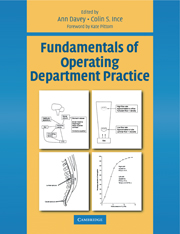Book contents
- Frontmatter
- Contents
- Contributors
- Preface
- Foreword
- Acknowledgements
- Introduction
- Chapter 1 The operating department practitioner, the patient and the law
- Chapter 2 Aspects of health and safety in the operating department
- Chapter 3 The caring practitioner
- Chapter 4 Strategies for infection control in the operating department
- Chapter 5 Sterilization, decontamination and the surgical field
- Chapter 6 The fundamentals of cardiovascular physiology
- Chapter 7 Fundamentals of respiratory physiology
- Chapter 8 Scientific principles in relation to the anaesthetic machine
- Chapter 9 Fundamentals of artificial ventilation of the lung
- Chapter 10 Scientific principles in relation to monitoring equipment
- Chapter 11 Scientific principles in relation to endoscopic, laser and radiological equipment
- Chapter 12 Pharmacological principles of drug administration
- Chapter 13 The pharmacology of drugs used in general anaesthesia
- Chapter 14 The local anaesthetic drugs - does the ideal agent exist?
- Chapter 15 The safe positioning of patients for surgery
- Chapter 16 Principles involved in the management and use of equipment
- Chapter 17 Understanding suture materials
- Chapter 18 Fundamentals ofpaediatric surgery and anaesthesia
- Chapter 19 Fundamentals of hyperthermia and hypothermia
- Chapter 20 Fundamentals of fluid and electrolyte balance during surgery
- Chapter 21 The physiology of blood and its administration
- Chapter 22 Fundamentals of pain relief
- Chapter 23 Fundamentals of dressings and drains in relation to wound healing
- Chapter 24 The recovery of patients from anaesthesia and surgery
- Chapter 25 Fundamentals of emergency and obstetric anaesthesia
- Chapter 26 Identification and management of anaesthetic emergencies
- Chapter 27 The fundamentals of emergency resuscitation
- Appendixes
- Index
Chapter 5 - Sterilization, decontamination and the surgical field
Published online by Cambridge University Press: 05 October 2015
- Frontmatter
- Contents
- Contributors
- Preface
- Foreword
- Acknowledgements
- Introduction
- Chapter 1 The operating department practitioner, the patient and the law
- Chapter 2 Aspects of health and safety in the operating department
- Chapter 3 The caring practitioner
- Chapter 4 Strategies for infection control in the operating department
- Chapter 5 Sterilization, decontamination and the surgical field
- Chapter 6 The fundamentals of cardiovascular physiology
- Chapter 7 Fundamentals of respiratory physiology
- Chapter 8 Scientific principles in relation to the anaesthetic machine
- Chapter 9 Fundamentals of artificial ventilation of the lung
- Chapter 10 Scientific principles in relation to monitoring equipment
- Chapter 11 Scientific principles in relation to endoscopic, laser and radiological equipment
- Chapter 12 Pharmacological principles of drug administration
- Chapter 13 The pharmacology of drugs used in general anaesthesia
- Chapter 14 The local anaesthetic drugs - does the ideal agent exist?
- Chapter 15 The safe positioning of patients for surgery
- Chapter 16 Principles involved in the management and use of equipment
- Chapter 17 Understanding suture materials
- Chapter 18 Fundamentals ofpaediatric surgery and anaesthesia
- Chapter 19 Fundamentals of hyperthermia and hypothermia
- Chapter 20 Fundamentals of fluid and electrolyte balance during surgery
- Chapter 21 The physiology of blood and its administration
- Chapter 22 Fundamentals of pain relief
- Chapter 23 Fundamentals of dressings and drains in relation to wound healing
- Chapter 24 The recovery of patients from anaesthesia and surgery
- Chapter 25 Fundamentals of emergency and obstetric anaesthesia
- Chapter 26 Identification and management of anaesthetic emergencies
- Chapter 27 The fundamentals of emergency resuscitation
- Appendixes
- Index
Summary
INTRODUCTION
The provision of sterile surgical supplies is of paramount importance if such supplies are to be used with safety in the treatment of patients. The failure to follow recognized guidelines for the sterilization, disinfection and cleaning of surgical supplies and instruments renders the patient liable to infection, which could result in an increased hospital stay or in certain cases cause infections that are serious enough to bring about a fatality.
The complexity of modern materials used in the manufacture of medical and surgical equipment means that no single sterilization process is adequate to meet the needs of this changing environment. Flexible fibreoptic endoscopes are easily damaged by heat, as are specialist catheters and these materials require specialist sterilization methods. These range from chemical sterilizing agents and the use of toxic gases such as ethylene oxide to the more recent gas plasma systems, which utilize peracetic acid or hydrogen peroxide as the sterilant in conjunction with a radio frequency energy source.
Public awareness of the human immunodeficiency virus (HIV) and other viruses such as hepatitis B has highlighted the need for staff working within the Sterile Supply Department to pay scrupulous attention to the decontamination procedures in use. In addition, procedures should be in place to constantly monitor all aspects of the process. These include the maintenance of the equipment used in the decontamination process, microbiological monitoring and the storage and handling of raw materials. High-profile media coverage relating to salmonella in eggs, Creutzfeldt Jakob disease (CJD) and bovine spongiform encephalopathy (BSE) has also fuelled the need to have systems in place to ensure the adequate decontamination of equipment and materials. However, it should be noted that when dealing with the viruses associated with CJD, BSE and scrapie (in sheep), specialist guidance relating to decontamination and sterilization should be sought from the Control of Infection Microbiologist or other qualified person.
TERMINOLOGY
The misuse of terminology when addressing the subject of sterilization and disinfection frequently occurs and it is important from the outset to establish the correct meanings associated with each term.
- Type
- Chapter
- Information
- Fundamentals of Operating Department Practice , pp. 43 - 52Publisher: Cambridge University PressPrint publication year: 1999



